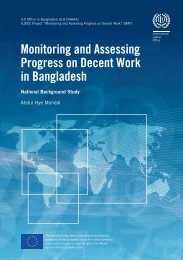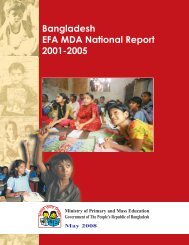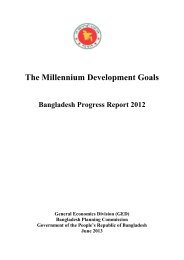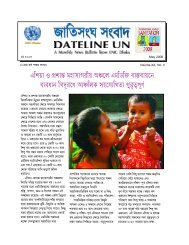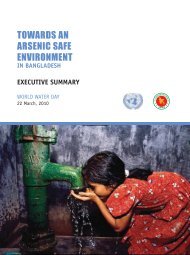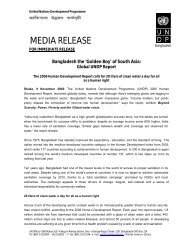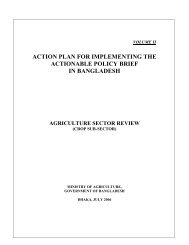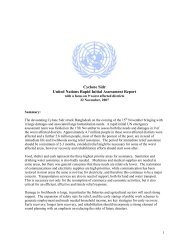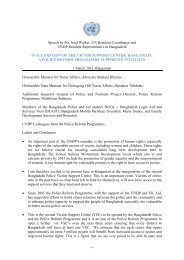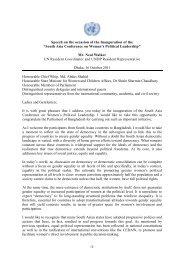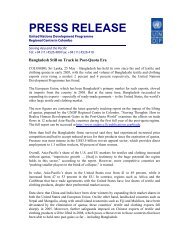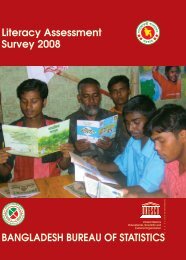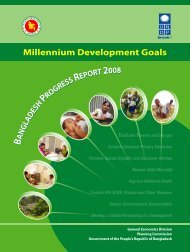Acknowledgements People's Report 2002-2003 : <strong>Bangladesh</strong> Environment (Volumes I & II) is the f<strong>in</strong>al outcome of the dedicated efforts of a number of <strong>in</strong>dividuals, groups, stake holders and agencies, who have shared their experience, perspective and labour <strong>in</strong> construct<strong>in</strong>g this edition’s profile on the <strong>Bangladesh</strong> environment and related issues. The editors gratefully acknowledge, <strong>in</strong> particular, the contribution of the follow<strong>in</strong>g <strong>in</strong>dividuals and agencies. AGENCIES <strong>Bangladesh</strong> Agricultural Development Corporation (BADC); <strong>Bangladesh</strong> Agricultural Research Council (BARC); <strong>Bangladesh</strong> Livestock Research Institute (BLRI); <strong>Bangladesh</strong> Bureau of Statistics (BBS); <strong>Bangladesh</strong> Fisheries Research Institute (BFRI); <strong>Bangladesh</strong> Centre for Advanced Studies (BCAS); <strong>Bangladesh</strong> Institute of Development Studies (BIDS); Dhaka Water Supply and Sewerage Authority (DWASA); <strong>Bangladesh</strong> University of Eng<strong>in</strong>eer<strong>in</strong>g and Technology (BUET); Department of Environment (DoE); M<strong>in</strong>istry of Environment and Forest (MoEF); Project Management Unit (PMU), Susta<strong>in</strong>able Environment Management Programme (SEMP); Department of Fisheries (DoF), M<strong>in</strong>istry of Fisheries and Livestock (MoFL); Dhaka City Corporation (DCC); Centre for Susta<strong>in</strong>able Development (CSD); <strong>Bangladesh</strong> Agricultural University, Mymens<strong>in</strong>gh; <strong>Bangladesh</strong> Tea Research Institute; Co-operation for American Relief Everywhere (CARE); The World Conservation Union (IUCN); The World Commission on Environment and Development (WCED); Department of Public Health Eng<strong>in</strong>eer<strong>in</strong>g (DPHE); <strong>Bangladesh</strong> Water Development Board (BWDB); <strong>Bangladesh</strong> Poribesh Andolon (BAPA); Food and Agricultural Organization (FAO); Water Resource Plann<strong>in</strong>g Organization (WARPO); <strong>Bangladesh</strong> Chemical Industries Corporation (BCIC) and World Bank. CONTRIBUTORS Dr. Abdul Ghani, Abdul Khalek Farooque, Abul Momen, Dr. Abdur Rob Khan, A.H. Md. Maqsood S<strong>in</strong>ha, Ahsen Ahmad, Dr. A.K. Podder, A.K.M. Mosidul Islam, Dr. A.N. Hasna Banu, Arifur Rahman, Asif-Uz-Zaman Khan, Farooque Chowdhury, Gouranga Nandi, Iftekhar Enayetullah, Jobair B. Alam, Kazi Zaker Hossa<strong>in</strong>, K. M. Moniruzzaman, Mahfuz Kabir, Dr. Mahfujul Haque, Dr. M Asaduzzaman, Dr. M. Ashraf Ali, Mehedi Ahmed Ansary, Dr. Mizan R Khan, Mirza Safiqur Rahman, Dr. M. Shah Alam Khan, Dr. M. Ismail Hossa<strong>in</strong>, Dr. Mushfique Ahmed, Nazrul Islam, Noor M. Kazi, Dr. P. K. Motiur Rahman, Reaz Ahmed, Rita Afsar, Saif Ul Haque, Dr. Saleemul Haq, Dr. Selim Bhuyan and Syed Abul Hasan. RESOURCE PERSONS A B M Shamsudd<strong>in</strong>, Abdur Rashid, Plant Protection Inspector, AED; Abdus Salam, BWDB; Ajit Kumar Saha, Upazilla Fisheries Officer, Netrokona; Akhil Kumar Biswas, SDE; Amir Hossa<strong>in</strong>, A N M Kaiser Zillany, CARE; Mr. Pradip, CARE; Anil Udd<strong>in</strong>, Upazilla Statistical Officer, Barohatta, Netrokona; Anowarul Haq, Project Development Officer, CARE; A S M Wobaidullah, Chairman, Department of Geology, Dhaka University; Bishojit Bhattacharja, Animal Nutrition Section, Department of Livestock Service; Ejaj Ahmad, <strong>in</strong>dependent researcher; Iffat Mahmod, <strong>in</strong>dependent researcher; Dr. Jahangir Alam (BARC), Kazi Bazlur Rahman, General Manager BSCIC; Laila Arjumand Banu, Upazilla Livestock Officer, Department of Livestock Services; Dr. Monirudd<strong>in</strong> Ahmed, Pr<strong>in</strong>cipal Scientific Officer, Entomology Division, <strong>Bangladesh</strong> Tea Research Institute, Srimangal, Moulvibazar; Najumul Haq, M A Hannan, MD Abdus Samad, Mohammad Aftab Udd<strong>in</strong> Fakir, Assistant Upazilla Fisheries Officer, Netrokona; Mohammad Asadullah Sheikh, CARE; Mohammad Moslem Udd<strong>in</strong>, Technical Officer, CARE; Mijarul Quayes, Editorial Consultant; Paritosh Kumar Roy, Assistant Health Inspector, Netrokona; Dr Selim Bhuiyan, <strong>Bangladesh</strong> Water Development Board, Shamsul Haq, Assistant Eng<strong>in</strong>eer, BWDB, Netrokona; Mrs Shamsun Nahar, District NGO Monitor<strong>in</strong>g Officer and Tarique Hossa<strong>in</strong>, Monitor<strong>in</strong>g and Evaluation Officer, Mymens<strong>in</strong>gh Agriculture Extension Project. DATA COLLECTION and COMPILATION Research Officers Hamim Kamrul Haque, M. Anowar Hossa<strong>in</strong>, Novera Hossa<strong>in</strong>, Rahela Rabbani, Tahm<strong>in</strong>a Sultana and Volunteers Fahmida Akther, Riaz Udd<strong>in</strong> and Tanjima Taslim of Unnayan Shamannay. FIELD WORK Tahm<strong>in</strong>a Sultana and Rahela Rabbani, Research Officers of Unnayan Shamannay; Am<strong>in</strong>ul Huq, Harunar Rashid. A.K.M Muksudul Alam, Md. Maghfur Hossa<strong>in</strong>, Fahmida Akther, Nazma Chowdhury, Shahiduzzaman Masud, Biplob Kumar Bose, P<strong>in</strong>aki Roy, Ananta Kumar Das, Abdul Khaleque Farooque, Gauranga Nandi, Rafiqul Islam Montu, Sharif Chowhan, Chandra Shekhar Das, Mohon Kumar Mandal, Monu Gupta, Tahirul Islam Milon, Kamal Ahmed, Biplob Sarkar and Iffat Ara.
In the last People's Report (People's Report on <strong>Bangladesh</strong> Environment 2001), we published a separate volume conta<strong>in</strong><strong>in</strong>g data on environmental issues. The data were gathered from a wide range of sources, <strong>in</strong>clud<strong>in</strong>g the database of the <strong>Bangladesh</strong> Bureau of Statistics (BBS), journals, and research reports, as well as from <strong>in</strong>dividual researchers. Our modest effort was appreciated by many. We therefore cont<strong>in</strong>ued our efforts <strong>in</strong> compil<strong>in</strong>g data on environmental issues and prepared this volume of environmental database for People's Report 2002-2003. In this volume of environmental database, we have not reproduced the data already reported <strong>in</strong> the Volume II of People's Report 2001. Only new data have been <strong>in</strong>cluded <strong>in</strong> this volume. The data have been presented <strong>in</strong> ten chapters and a format similar to that <strong>in</strong> the People's Report 2001, has been followed. In the last People's Report, we relied a great deal on data compiled by the <strong>Bangladesh</strong> Bureau of Statistics (BBS). This time, we gathered data primarily from other sources, <strong>in</strong>clud<strong>in</strong>g journals, research reports, conference proceed<strong>in</strong>gs, and data published by different government agencies and non-government research organizations. Like last time, we put significant effort to f<strong>in</strong>d out any <strong>in</strong>consistency <strong>in</strong> the reported data and tried to verify the data, that we thought <strong>in</strong>consistent, with the orig<strong>in</strong>al source. This was not an easy task and our research officers worked very hard to verify the authenticity of the data. In some cases, we decided not to report some of the data could not be verified. We would like to po<strong>in</strong>t out that we have not <strong>in</strong>cluded data that are very volum<strong>in</strong>ous <strong>in</strong> nature and not suitable for publication <strong>in</strong> pr<strong>in</strong>t format. Besides, <strong>in</strong> most cases, such data are available <strong>in</strong> suitable versions from other sources. The Department of Public Health Eng<strong>in</strong>eer<strong>in</strong>g- British Geological Survey (DPHE-BGS) database on groundwater quality, <strong>in</strong>clud<strong>in</strong>g arsenic concentration, <strong>in</strong> <strong>Bangladesh</strong> is an example. We are <strong>in</strong>deed very grateful to all who provided us data and helped us collect, check and re-check those. Our special thanks to the Unnayan Shamannay research staff for their efforts and hard-work <strong>in</strong> collect<strong>in</strong>g, compil<strong>in</strong>g and check<strong>in</strong>g the database. We also express our s<strong>in</strong>cere gratitude to the specialists of the Programme Management Unit (PMU) of SEMP for encourag<strong>in</strong>g us <strong>in</strong> this endeavour.
- Page 2 and 3: People's Report 2002-2003 BANGLADES
- Page 4 and 5: First published December 2004 © Un
- Page 6 and 7: vi Table 1.2.26 Arsenic Concentrati
- Page 8 and 9: viii Table 3.1.1.4 Numbers and Area
- Page 10 and 11: x Table 6.1.3 Supply and Consumptio
- Page 12 and 13: xii Table 9.1.9 Casualty Distributi
- Page 16: Chapter 1 Land and Agriculture 1.1
- Page 19 and 20: 4 People's Report 2002-2003 : Bangl
- Page 21 and 22: Table 1.1.6 Summary of Tea Garden L
- Page 23 and 24: 8 People's Report 2002-2003 : Bangl
- Page 25 and 26: Table 1.2.7 The Summary of Concentr
- Page 27 and 28: 12 People's Report 2002-2003 : Bang
- Page 29 and 30: 14 People's Report 2002-2003 : Bang
- Page 31 and 32: 16 People's Report 2002-2003 : Bang
- Page 33 and 34: 18 People's Report 2002-2003 : Bang
- Page 35 and 36: 20 People's Report 2002-2003 : Bang
- Page 37 and 38: 22 People's Report 2002-2003 : Bang
- Page 39 and 40: 24 People's Report 2002-2003 : Bang
- Page 41 and 42: Table 1.2.38 Crop Variety Developed
- Page 43 and 44: 28 People's Report 2002-2003 : Bang
- Page 45 and 46: 30 People's Report 2002-2003 : Bang
- Page 47 and 48: 32 People's Report 2002-2003 : Bang
- Page 49 and 50: 34 People's Report 2002-2003 : Bang
- Page 51 and 52: 36 People's Report 2002-2003 : Bang
- Page 53 and 54: 38 People's Report 2002-2003 : Bang
- Page 55 and 56: 40 People's Report 2002-2003 : Bang
- Page 57 and 58: 42 People's Report 2002-2003 : Bang
- Page 59 and 60: 44 People's Report 2002-2003 : Bang
- Page 61 and 62: 46 People's Report 2002-2003 : Bang
- Page 63 and 64: 48 People's Report 2002-2003 : Bang
- Page 65 and 66:
50 People's Report 2002-2003 : Bang
- Page 67 and 68:
52 People's Report 2002-2003 : Bang
- Page 70 and 71:
Forestry 55 2.1 Basic Statistics Ta
- Page 72 and 73:
Forestry 57 Table 2.1.5 The 15 Noti
- Page 74 and 75:
Forestry 59 Table 2.1.7 Management
- Page 76 and 77:
Forestry 61 2.2 Forest Product Tabl
- Page 78 and 79:
Forestry 63 Table 2.3.5 Estimated P
- Page 80 and 81:
Forestry 65 Table 2.3.6 Species Nam
- Page 82 and 83:
Forestry 67 Table 2.3.6 Species Nam
- Page 84 and 85:
Forestry 69 Table 2.3.8 Species nam
- Page 86:
Chapter 3 Fisheries and Livestock 3
- Page 89 and 90:
74 People's Report 2002-2003 : Bang
- Page 91 and 92:
76 People's Report 2002-2003 : Bang
- Page 93 and 94:
78 People's Report 2002-2003 : Bang
- Page 95 and 96:
80 People's Report 2002-2003 : Bang
- Page 97 and 98:
82 People's Report 2002-2003 : Bang
- Page 99 and 100:
84 People's Report 2002-2003 : Bang
- Page 101 and 102:
86 People's Report 2002-2003 : Bang
- Page 104 and 105:
Water 89 4.1 Surface Water, Flood a
- Page 106 and 107:
Table 4.1.5 Flood Affected Areas, M
- Page 108 and 109:
Table 4.1.5 Flood begins (Date) Aff
- Page 110 and 111:
Table 4.1.5 Flood begins (Date) Aff
- Page 112 and 113:
Table 4.1.7 Flood Affected Areas, M
- Page 114 and 115:
Table 4.1.7 Thana Union Affected Fa
- Page 116 and 117:
Table 4.1.7 Thana Union Affected Fa
- Page 118 and 119:
Water 103 Table 4.2.2 Regional Vari
- Page 120 and 121:
Water 105 Table 4.2.6 Source of Wat
- Page 122 and 123:
Water 107 Table 4.2.13 Water Pricin
- Page 124 and 125:
Water 109 4.3 Water Quality Table 4
- Page 126 and 127:
Water 111 Table 4.3.2b Cr (mg/L) Co
- Page 128:
Chapter 5 Industry 5.1 Waste Genera
- Page 131 and 132:
116 People's Report 2002-2003 : Ban
- Page 133 and 134:
118 People's Report 2002-2003 : Ban
- Page 136 and 137:
Energy 121 6.1 Energy Source and Co
- Page 138 and 139:
Energy 123 Table 6.2.2 Existing Co-
- Page 140 and 141:
Energy 125 6.3 Natural Gas and Oil
- Page 142 and 143:
Energy 127 Table 6.3.4 Natural Gas
- Page 144:
Chapter 7 Urbanization 7.1 People a
- Page 147 and 148:
132 People's Report 2002-2003 : Ban
- Page 149 and 150:
134 People's Report 2002 : Banglade
- Page 151 and 152:
136 People's Report 2002-2003 : Ban
- Page 153 and 154:
138 People's Report 2002-2003 : Ban
- Page 155 and 156:
140 People's Report 2002-2003 : Ban
- Page 157 and 158:
142 People's Report 2002-2003 : Ban
- Page 160 and 161:
Population Health and Nutrition 145
- Page 162 and 163:
Population Health and Nutrition 147
- Page 164 and 165:
Table 8.3.5 Status of Urban Water a
- Page 166 and 167:
Table 8.3.5 Sirajganj Natore Naogao
- Page 168 and 169:
Table 8.3.5 Gaibandha Kurigram Lalm
- Page 170 and 171:
Table 8.3.6 Population Shallow Tube
- Page 172 and 173:
Table 8.3.6 Population Shallow Tube
- Page 174 and 175:
Table 8.3.6 Population Shallow Tube
- Page 176 and 177:
Table 8.3.6 Population Shallow Tube
- Page 178 and 179:
Table 8.3.6 Population District: Th
- Page 180:
Chapter 9 Transport and Communicati
- Page 183 and 184:
168 People's Report 2002-2003 : Ban
- Page 185 and 186:
170 People's Report 2002-2003 : Ban
- Page 187 and 188:
172 People's Report 2002-2003 : Ban
- Page 190 and 191:
Climate 175 10.1 Rainfall Table 10.
- Page 192 and 193:
Climate 177 10.2 Global Climate Cha
- Page 194 and 195:
Climate 179 Table 10.2.5 Changes in
- Page 196 and 197:
Climate 181 Table 10.3.4 Main Areas
- Page 198 and 199:
References CHAPTER 1 Ahmed, M. F.,
- Page 200 and 201:
References 185 Razzaque, M. A. (200
- Page 202 and 203:
References 187 CHAPTER 6 Alam, M.,
- Page 204:
References 189 Iqbal, M. A., Ahmed,



